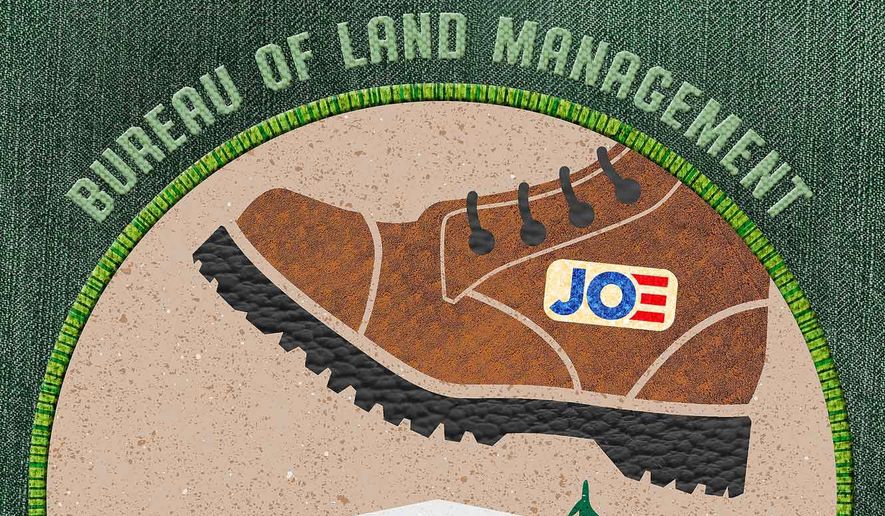OPINION:
Protecting lands and waters is central to America’s conservationist ethos.
Americans, by and large, desire to maintain beautiful spaces and see flora and fauna thrive. But if the Biden administration gets its way in enacting its 30-by-30 initiative — a push to “conserve” 30% of waters and lands by 2030 — true conservation would be undermined and private property rights would be severely threatened.
Upon first review, the initiative, stemming from President Biden’s first executive order “Tackling the Climate Crisis at Home and Abroad,” appears harmless. That’s intended. It promises a “collaborative and inclusive approach to conservation,” “supporting locally led and locally designed conservation efforts” and “conserving America’s lands and waters for the benefit of all people.”
Don’t be deceived by these niceties.
To better push its 30-by-30 initiative, the Department of the Interior rebranded it with a more disarming name: the “America the Beautiful” campaign. It suggests the push for the plan is “for the sake of our economy, our health, and our well-being.” But the details contained in “America the Beautiful” intentionally mislead the public about the current status of our nation’s lands and waters.
For starters, the Biden administration deceptively claims only 12% of U.S. lands and waters, or less than a fifth, are already set aside for noncommercial activities. This is patently false.
By examining the federal government’s own numbers, the heavily cited 12% figure severely undercounts the amount of lands and waters already protected.
According to the U.S. Geological Survey’s Gap Analysis Project on the Protected Areas Database of the U.S., the total amount of land in the U.S. amounts to 622,630,476 acres, of which 252,758,091 are already protected from human activity. When calculated, that number rounds out to a whopping 40.6% — not 12% — of lands closed off to multiple-use.
With the 30% goal already achieved, the “America the Beautiful” initiative doesn’t accurately reflect or seek to advance true conservation that encourages multiple uses on public lands.
Like their extremist environmentalist backers, the Biden administration is using 30-by-30 to deceptively conflate conservation (wise use of natural resources) with its own goals of preservation (no use). They do this not so much to improve the natural world, but to acquire more land whereby the government and their allies in the Green movement will have more authority over natural resources management.
Although the plan gives a nod to private property rights and recognizes sportsmen and women as key drivers, it fails to define a baseline of existing conservation practices and measurements of success, and doesn’t clearly define what it means by “conservation.”
Another concerning aspect of the Biden plan is that it intends to create something called the American Conservation and Stewardship “Atlas.” While details are scant, it appears to be an effort to create a database of sorts that can be used as a “comprehensive tool through which to measure the progress of conservation, stewardship and restoration efforts across the United States.”
Why is this troubling? Because undoubtedly, the creation of such an Atlas would entail federal officials trotting onto private lands to obtain its needed information, and this opens the door wide for serious abuse of data and privacy concerns. Indeed, if history is any example, such an Atlas would expose every farmer, rancher, forester and landowner to potential harassment and inquiries from federal bureaucrats eager to find whatever endangered species, wetland or sensitive ecosystem exists on it.
The Biden Administration would do well to remember the Tenth Amendment to the U.S. Constitution: “The powers not delegated to the United States by the Constitution, nor prohibited by it to the States, are reserved to the States respectively, or to the people.”
If the federal government is already “conserving” 40% of lands and waters, then what is the 30-by-30 plan but a federal power grab? Indeed, the vague language targeting “private, State, local, Tribal, and territorial lands” and the creation of the massive Atlas threatens to trample all over the very concept of federalism, private property rights and privacy.
If the Biden administration desired to advance true conservation efforts — not simply lock up public lands to multiple uses — they’d focus on actual solutions to conservation issues. Things like improving our response to and management of forest fires, controlling invasive species and better mitigating Superfund pollution sites.
Opposition to Biden’s 30-by-30 agenda is growing. Many of those actual solutions listed above are lined out in a long alternative to land management presented by the Western Caucus called “Western Conservation Principles.” Bills in both the House and Senate have been introduced to nullify its implementation.
Efforts to “modernize” effective stewardship practices like Biden’s 30-by-30 plan would adversely alter America’s conservation landscape and seriously imperil private property rights. It should be opposed on these grounds.
• Gabriella Hoffman serves as communications administrator with CFACT and is host of the District of Conservation podcast.




Please read our comment policy before commenting.